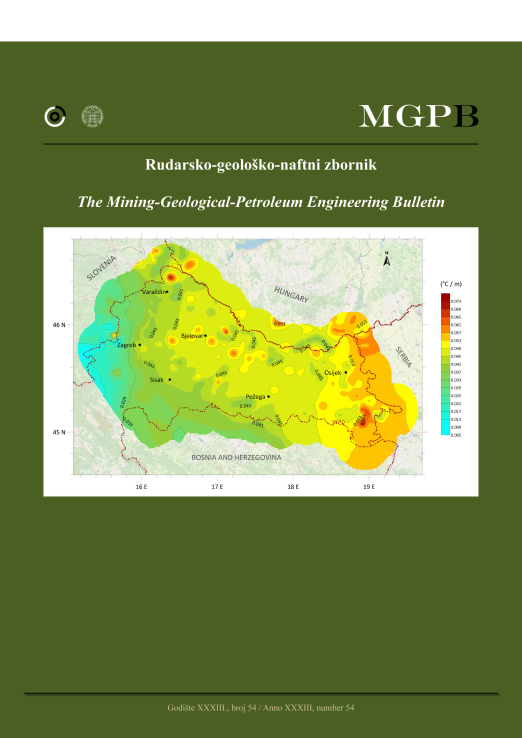Defining geoexchange extraction rates in the same geological environment for different borehole geometry settings – Pilot results from the HAPPEN - HORIZON 2020 project
DOI:
https://doi.org/10.17794/rgn.2021.3.7Keywords:
borehole heat exchanger, geological environment, geothermal gradient, heat extraction ratesAbstract
Kindergarten Grdelin in the city of Buzet, Istria, Croatia, was chosen to undergo a deep retrofit of the current thermotechnical system, as a part of the HORIZON 2020 HAPPEN project1. The existing shallow spiral heat exchanger field is insufficient to cover heating loads of the building. Therefore, additional BHEs were drilled and completed to determine optimal borehole heat exchanger type within the same geological environment. Four BHEs, either single U (1U) or double U (2U), with different geometrical setting and depth were tested: BHE-1 (50 m, 2U DN32 ribbed), BHE-2 (75 m, 2U DN40 ribbed), BHE-3 (100 m, 2U DN32 smooth) and BHE-4 (150 m, 1U DN45 ribbed). A thermal response test (TRT) was performed to obtain the ground thermal properties. Furthermore, synthetic TRT curves were calculated to describe temperature response in the case of different heat pulses. This was done to determine heat extraction rates and the capacity of each BHE type, according to EN14511 norm. It was established that the BHE-4 is the optimal design for heating and cooling purposes on the selected site due to positive impact of the geothermal gradient, higher initial borehole temperature and a positive effect of the ribbed inner wall.
[1] This paper reflects only the view of the authors and the Commission is not responsible for any use that may be made of the information it contains.
Downloads
Published
How to Cite
Issue
Section
License
Copyright (c) 2021 authors and journal

This work is licensed under a Creative Commons Attribution 4.0 International License.
Creative Commons-BY
Authors who publish with this journal agree to the following terms:
In agreeing this form, you certify that:
- You read the ethical codex of the RGN zbornik available at journal web.
- You submitted work is your original work, and has not previously been published and does not include any form of plagiarism.
- You own copyright in the submitted work, and are therefore permitted to assign the licence to publish to RGN zbornik.
- Your submitted work contains no violation of any existing copyright or other third party right or any material of an obscene, libellous or otherwise unlawful nature.
- You have obtained permission for and acknowledged the source of any illustrations, diagrams or other material included in the work of which you are not the copyright owner.
- You have taken due care to ensure the accuracy of the work, and that, to the best of your knowledge, there are no false statements made within it.
- All co-authors of this submitted work are aware of, and in agreement with, the terms of this licence and that the submitted manuscript has been approved by these authors.
Publication licence
You retain copyright in your submitted work, according to journal license policy (CC-BY). By signing this form you agree that RGN zbornik may publish it under the publication licence. In summary the licence allows the following:
Anyone is free:
- To copy, distribute, display, and perform the work.
- To make derivative works.
Under the following conditions:
- The original author must always be given credit.
- The work may not be used for commercial purposes.
- If the work is altered, transformed, or built upon, the resulting work may only be distributed under a licence identical to this one.
Exceptions to the licence
In addition to publishing the work printed under the above licence, RGN zbornik will also enable the work to be visible online.
The journal editorial can change the licence rules anytime but it cannot retroactively restrict author(s) rights.


